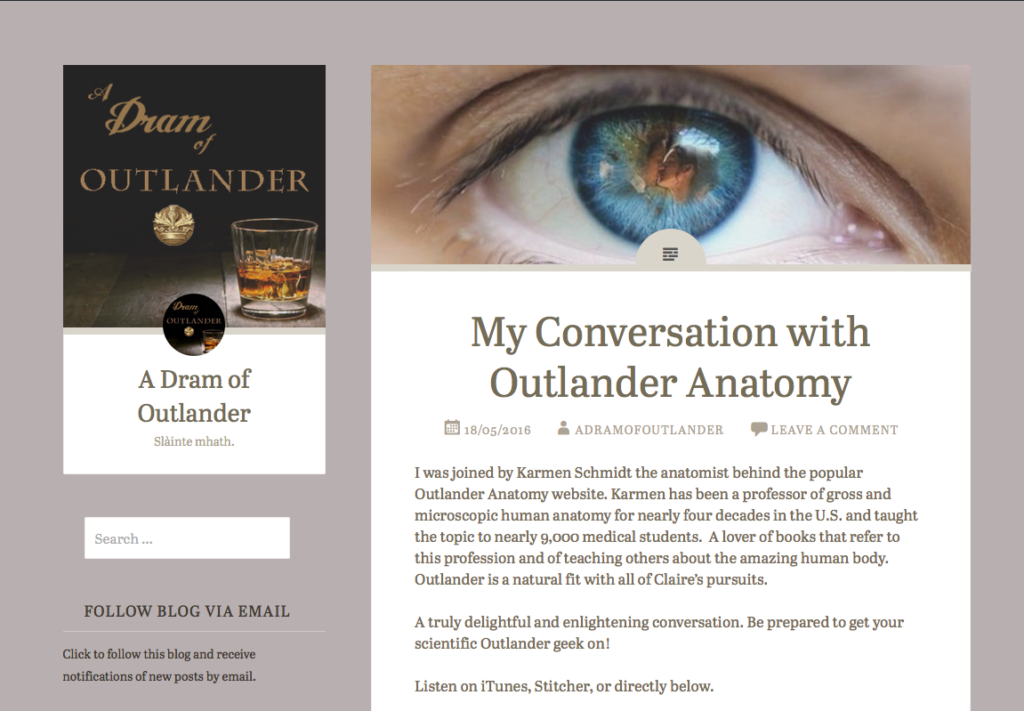
I had the good fortune of talking with Desirre Andrews from A Dram of Outlander this week! You can listen to the podcast on iTunes, Stitcher or on the website!
a deeply grateful,
Outlander Anatomist

Human Anatomy taught through the lens of the Outlander books by Diana Gabaldon and the Starz television series

I had the good fortune of talking with Desirre Andrews from A Dram of Outlander this week! You can listen to the podcast on iTunes, Stitcher or on the website!
a deeply grateful,
Outlander Anatomist
Hello, Outlander anatomy students, and welcome to today’s Anatomy Lesson #39, the Human Skeleton. This is a whopping subject so it will take two lesson to cover the bones!
Dem bones or dem dry bones refer to a spiritual song inspired by a vision recorded in the biblical Book of Ezekiel, 37:1-14. Ezekiel stands in a valley filled with dry human bones. Before his eyes and with the promise of hope, the bones join into human skeletons which become enshrouded with flesh. This wonderful spiritual has been rewritten for children:
Skeleton Lesson over! Naw, just kidding. The skeleton is a wee bit more complicated than the song lets on.
As if on cue, Starz Outlander team offers up a S.2 treasure trove of bone images just in time for our skeleton lesson.
Hum, look again, Claire, that cup isn’t half empty – it’s half full (Starz episode 204, La Madame Blanche)! Thank you, Outlander!
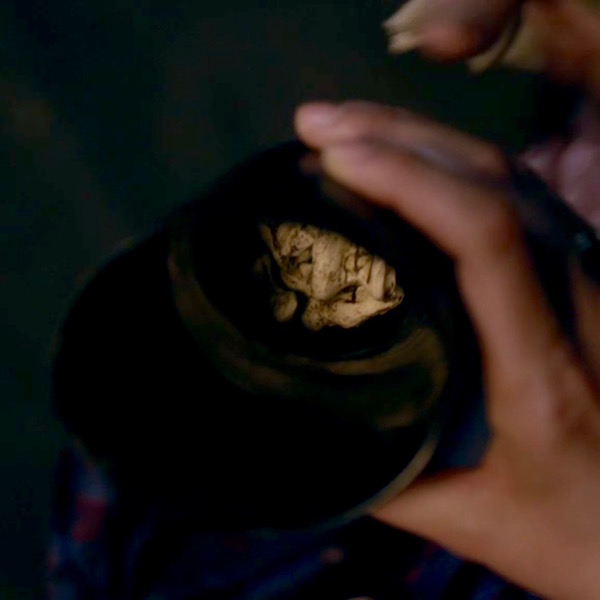
Claire glides into Master Raymond’s secret “little shop of horrors” overflowing with marvelous skulls from real and imagined beasties (Starz episode 204, La Madame Blanche). His wonderful ossuary includes a unicorn skull (lower right) embellished with head armor (chanfron for horses) complete with horn hole! A whimsical nod to the national animal of Scotland, no doubt. Love it!
Diana elaborates in Dragonfly in Amber.
Two walls of the hidden room were taken up by a honeycomb of shelves, each cell dustless and immaculate, each displaying the skull of a beast. …Tiny skulls, of bat, mouse and shrew, the bones transparent, little teeth spiked in pinpoints of carnivorous ferocity. …They had a certain appeal, so still and so beautiful, as though each object held still the essence of its owner, as if the lines of bone held the ghost of the flesh and fur that once they had borne.
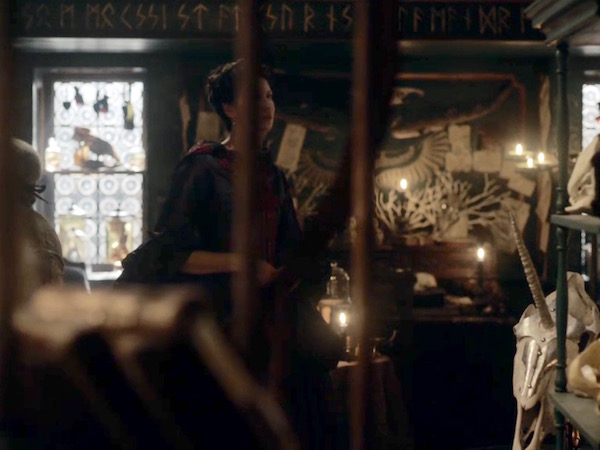
Claire examines an unusual skull, perhaps the remains of a horned carnivorous dinosaur such as carnotaurus (Latin meaning flesh bull). There are loads of horny creatures on Outlander. Ha, ha. Alas, such animals are no more declares Master Raymond. True, unless one takes a Spielberg detour to Isla Nublar!
Goddess of the Pen continues in DIA:
I reached out and touched one of the skulls, the bone not cold as I would have expected, but strangely inert, as though the vanished warmth, long gone, hovered not far off. ..“You see the teeth? An eater of fish, of meat”—a small finger traced the long, wicked curve of the canine… “Such beasts are no more, madonna.”
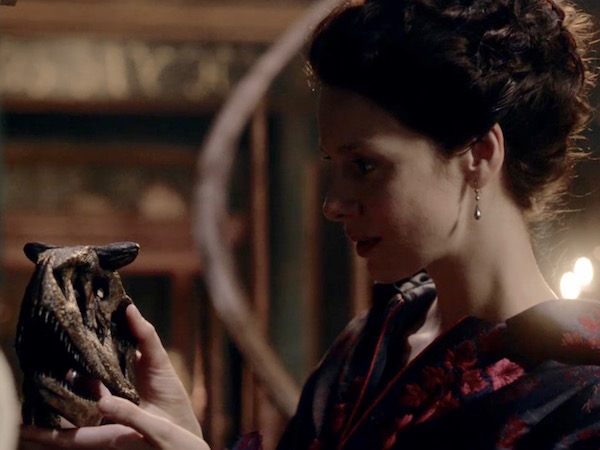
Interested in old stuff, Master Raymond might like this bony specimen for his awesome collection (Image A), a 130,000 y.o. Neanderthal skull. Found in a limestone cavern near Altamura, Italy, the bones are shrouded with cave popcorn, limestone formations caused by splashes of mineral-rich water. Wondrous!
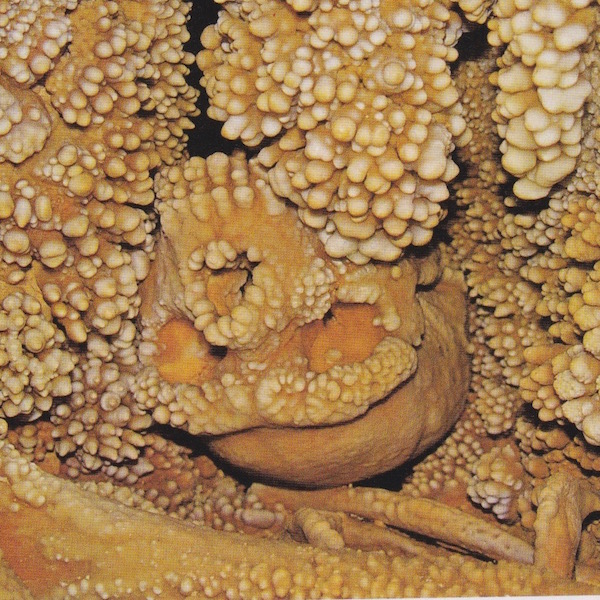
Image A
Master Raymond and his coy toys are endlessly fascinating, but it’s time to study the skeleton.
Gross anatomy (Anatomy Lesson #34, “History of Anatomy”) teaches bones and their relationships as they appear in the visible skeleton. We haven’t been exactly idle as prior anatomy lessons have discussed many individual bones. Some of these will be referenced in this lesson. Microscopic anatomy (Anatomy Lesson #34) studies bones as organs and tissues. Slightly different approaches and today’s lesson considers both.
Adult Human Skeleton: The word skeleton derives from the Greek skeletós, meaning “dried up”, because long after flesh has withered, the skeleton steadfastly remains (remains, get it? Hee hee). However, despite the definition, our skeletons are very much alive!
The skeleton forms the supporting structure of an organism. Some creatures, such as the Japanese beetle (Image B), have an exoskeleton (Greek exo- meaning outside), a stable outer shell to protect delicate innards, a type of organic armor. But exoskeletons present a couple of major disadvantages as grown and movement are limited.
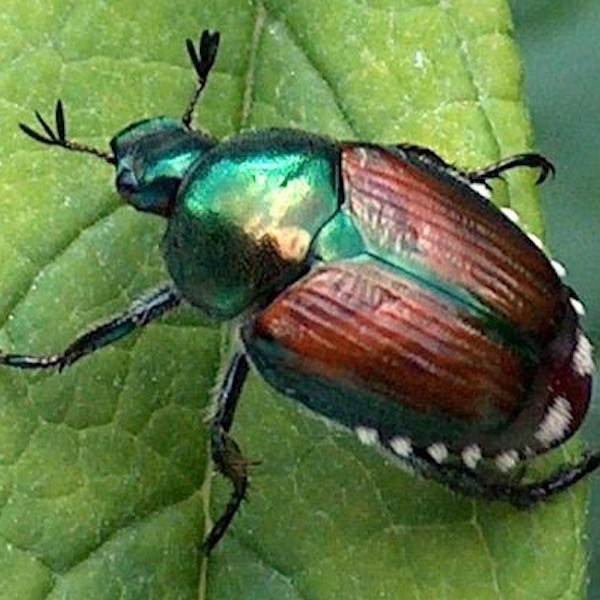
Image B
We humans don’t walk around with our skeletons exposed – unless we suffered a Randall-scandal with BJ! Rather, humans enjoy an endoskeleton (Greek endo- meaning within); our skeleton lies inside the body, wrapped in flesh. The endoskeleton is a genuine boon because it gifts its owner with freer movement and growth potential.
The skeleton (Image C) is a composite of all bones in a human body. It is also heavy, accounting for 20% of our total body weight. The adult human skeleton includes 206 individually named bones whereas, the infant human skeleton contains about 300. The overall count drops during maturation as many bones fuse (e.g. skull bones), usually completing the process after three decades of life.

Image C
Interestingly, the number of bones comprising the adult skeleton is always higher than 206, but, because some bones are not present in all people, are small, or are variable in number, they are excluded from the overall count. A couple of good examples follow.
Humans have small sesamoid bones (Latin meaning like a seed) housed within tendons of thumbs and great toes (Image D) where they influence the pull of muscles. These are not counted. The paired patellae (pl., knee caps) are the largest and best known sesamoid bones but, because of size and constancy, these are routinely included in the 206 count.
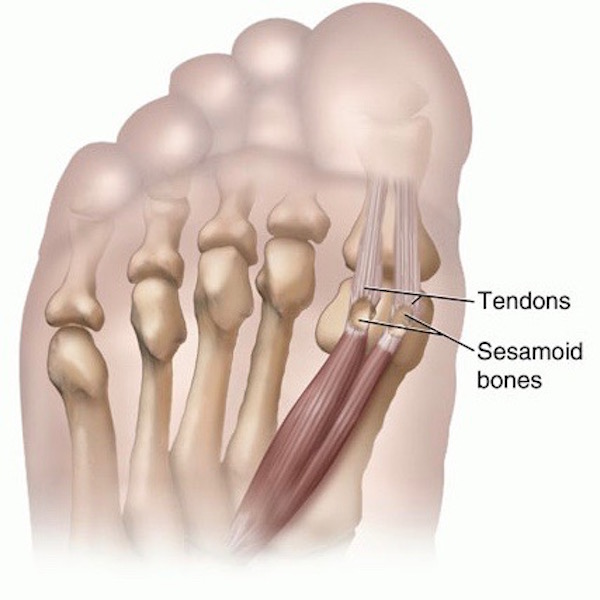
Image D
Another example of bones eliminated from the count are small, irregular wormian bones, which develop in sutures of the skull (Image E – red arrows). Although not rare, most skulls do not have them. Wormian bones can be markers of diseases such as brittle bone, but in normal individuals, their significance is unknown.
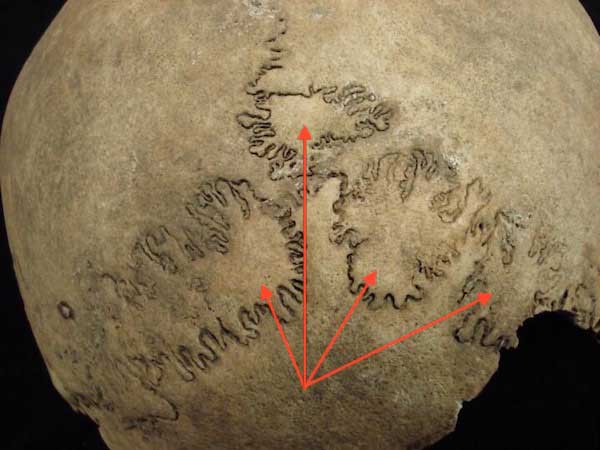
Image E
Back to the adult skeleton. The skeleton is divided into axial (Image F – yellow) and appendicular (Image F – green) parts. The axial skeleton includes bones of skull, vertebrae, sacrum, coccyx, ribs, and sternum, for a total of 80 bones. The appendicular skeleton houses bones of upper and lower limbs, including clavicle, scapula, and hip bones, for a total of 126.
Notice this, all bones of the adult appendicular skeleton are duplicated on each side of the body: two femurs, two humeri, (pl.) etc. However, the adult adult axial skeleton is variable: ribs and some facial bones are duplicated but all remaining axial bones are singular, lacking a counterpart. Three pairs of ear ossicles are good examples of duplicated skull bones (Anatomy Lesson #25, “If a Tree Falls – The Ear”). Whereas, the frontal bone of the skull is unpaired (Anatomy Lesson #11, “Jamie’s Face” or “Ye do it Face to Face?”).
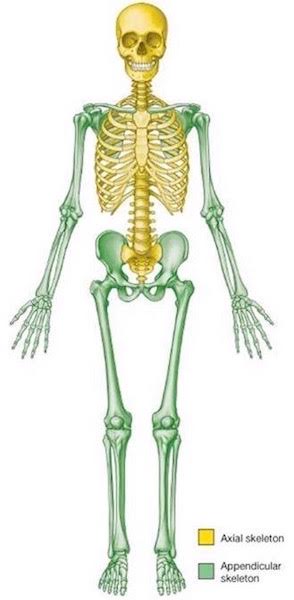
Image F
Bones are Secure: Bones of the skeleton don’t swing in the breeze; they are joined by connective tissue elements. Unmoveable joints (think skull sutures) are united by strong layers of collagen. Moveable joints (think elbows – Anatomy Lesson #20, “Arms! Arms! Arms! – Redux”) are sites where adjacent bones move on each other. To be more precise, the articular cartilages of such bones move on each other.
I cringe when my yoga teachers mention the bad “bone-on-bone” plank position. They really don’t mean this because bone-on-bone means the articular cartilages are worn away ensuring arthritis as one’s constant companion!
Image G shows the moveable knee joint, one of the largest and most complex of the body. The femur (Anatomy Lesson #7, “Jamie’s Thighs” or “Ode to Joy!”) and tibia (ditto) are stabilized by four major ligaments, muscle tendons, joint capsule (collagen again), and shock-absorbing menisci (pl.). Similar anatomical elements (sans menisci) compliment all moveable joints.
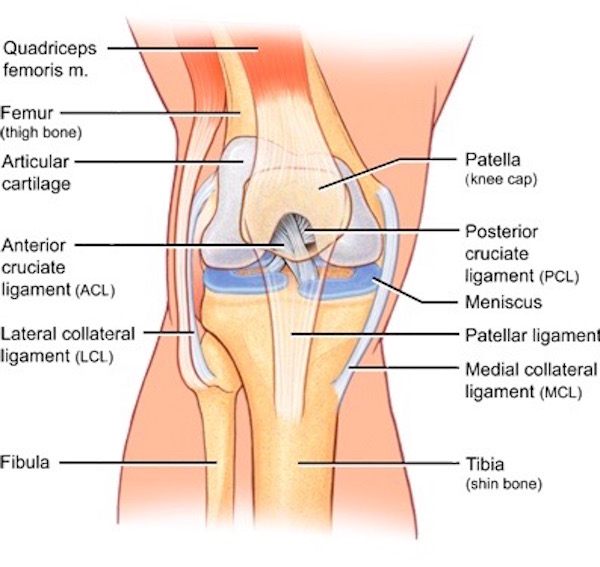
Image G
Bone Shape: Bones are classified into four categories based on shape: long, short, flat, and irregular (Image H). Most anatomists eliminate sesamoid and suture (wormian) bones from shape categories but all agree on the following four.
Long bones are longer than they are wide and are mostly confined to the appendicular skeleton where they engage in weight bearing and movement. Examples are femur, humerus, and phalanges. The femur (Anatomy Lesson #7, “Jamie’s Thighs” or “Ode to Joy!”) is the skeleton’s longest bone.
Short bones are as wide as they are long (cube-like), providing support and stability. Good examples are carpals of wrist (Anatomy Lesson #22, ”Jamie’s Hand – Symbol of Sacrifice”). The stapes (Anatomy Lesson #25, ”If a Tree Falls – The Ear”) of the middle ear is the skeleton’s shortest bone.
Flat bones are expanded into broad, flat planes. They protect underlying elements and/or provide wide muscle attachments. Good examples are bones of cranium, scapula, and sternum (Anatomy Lesson #15, “Crouching Grants – Hidden Dagger”).
Irregular bones have peculiar shapes; they provide protection and muscle attachment. Vertebrae and facial bones are good examples.
Now, the shape classification scheme is not without controversy as some bones cross boundaries, sharing elements of more than one category…. think of the flat and oddly-shaped scapula (Anatomy Lesson #2, “When Claire Meets Jamie” or “How to Fall in Love While Reducing a Dislocated Shoulder Joint!”).
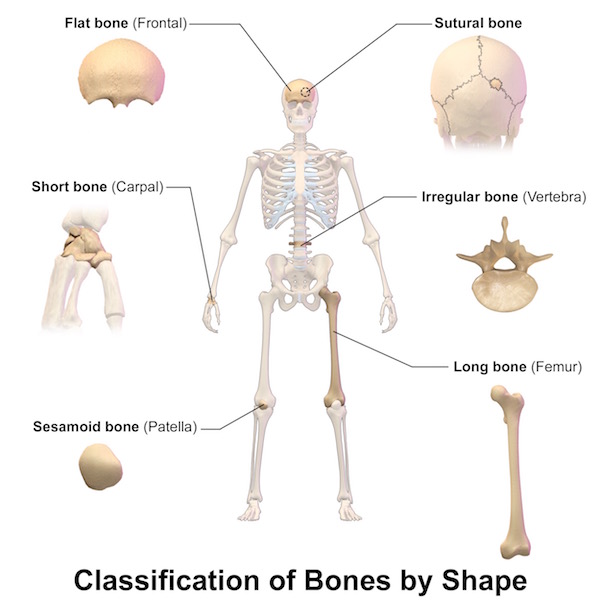
Image H
Bones as Organs: Now for some microscopic anatomy… an organ is a group of tissues that perform a function or group of functions. Like heart, lungs, liver, and brain, our bones are also living organs.
Bones are characterized by hard outer shells and “spongy interiors.” The outer shell is compact (cortical) bone; the interior is spongy (cancellous) bone, a distribution best illustrated using the femur (Image I). BTW, spongy bone is so named because it is riddled with holes, not because it is soft and pliable like the animal known as a sponge.
Parts of a Long Bone: Now for a crash course in bone anatomy. A long bone displays shaft (diaphysis), marrow cavity, and articular (epiphyses) ends (Image I). A connective tissue periosteum envelops the shaft and is richly endowed with pain fibers; anyone who has broken a bone kens this very well! Depending on the bone and age of its owner, the marrow cavity is filled with either fat (yellow marrow) or blood-forming tissue (red marrow). Both epiphyses are covered with smooth, firm articular cartilage (blue in Image I), which augments movement at the joints. Cancellous bone is abundant deep to the articular cartilage caps. Epiphyseal (growth) plates separate epiphyses (pl.) from shaft.
Growth plates are sites where long bones grow in length. Long bones continue lengthen until growth plates ossify, about two years after the onset of menstruation in girls and late teens for boys (there are variations). Whew, a packed mini-lesson!
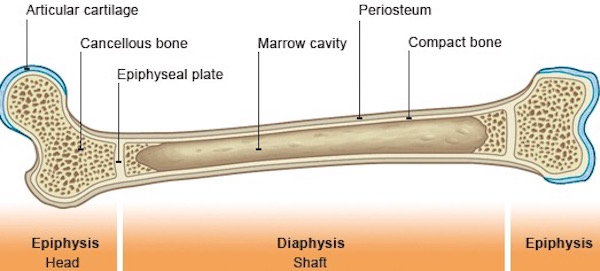
Image I
Bone as Tissue: Named bones are organs, but bone is also classified as a type of connective tissue. Tissue is an aggregation of similar cells and extracellular material acting together to perform specific functions. Connective tissues range from fluids, such as lymph and blood, to semi-solids or solids such as cartilage and bone.
As a tissue, bone is a composite of organic proteins and inorganic bone mineral. The organic protein is collagen, the most ubiquitous structural protein of the human body. Collagen is abundant in bone where it acts as a scaffold for the deposition of minerals. Inorganic bone mineral is made of hydroxyapatite, tiny crystals of calcium, phosphate, and magnesium which endow bone with rigidity. Understand that normal deposition of bone minerals is a complex process involving several hormones (e.g. calcitonin), dietary calcium, phosphorus, and magnesium,, and sufficient Vitamin D (via sunlight and/or supplements)!
Tidy Test: This bitty bone test demonstrates the relative roles of organic and inorganic components of bone. Bake a raw chicken bone at low temperature for a few hours. Immerse another raw chicken bone in acid (vinegar works OK but something stronger is better) for many days. Baking destroys collagen (organic protein) leaving the bone brittle and friable; it readily snaps in two. Soaking removes inorganic minerals leaving a rubbery bone that can be easily bent. I don’t expect you to try this demonstration, but it has been done for many years in school science labs.
A dry femur (Image J), offers a superb example of how bony tissue is organized. Covering the surface is a rind of hard, cortical bone of varying thickness. The cartilage covering the epiphysis is absent. The interior of the epiphysis is filled with spongy bone, a lattice of thin, hard bony shards. Spaces in the marrow cavity (red arrow) and amid the spongy bone are filled with either blood-forming tissue or fat, depending on the bone and one’s age.
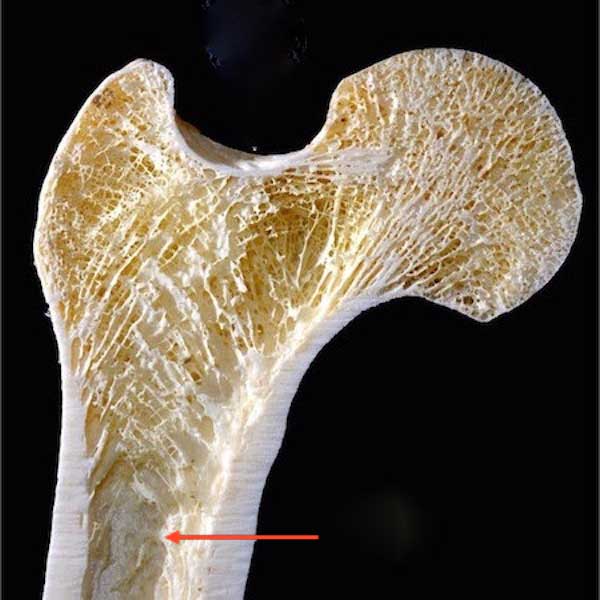
Image J
Time for another outlandish image (Starz episode 204, La Madame Blanche). No, lass, dinna ask Master Raymond about future Frank! Dem bones, dem bones, goin’ talk about… you don’t want to know the answer!
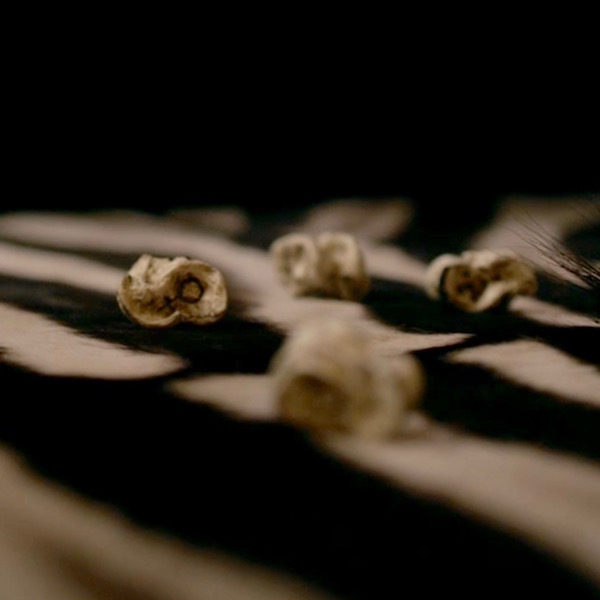
Which brings us to the very entertaining topic of sexual dimorphism. Don’t ask how I made that leap, it just seems to fit here! <G>
Sexual Dimorphism: Like many primates, the adult human skeleton exhibits sexual dimorphism; differences in form based on sex. Male skeletons are typically larger, heavier, and more massive than those of the female. There are also gender differences between some skull bones, canine teeth, and long bones (e.g. femur). But, the most reliable difference in discerning gender is via the bony pelvis. In 95% of cases, a skilled observer can assign an adult bony pelvis to the correct gender, although such differences are not evident before puberty.
To understand these sex-based differences, we must first consider anatomy of the bony pelvis (Image K), a ring formed by sacrum (yellow) and two hip bones (peachy-red). These three bones are held together by some of the body’s strongest ligaments. Why? Because, they bear the entire weight of torso, head and upper limbs, more than half our body weight!
BTW, I can immediately discern (with ~ 95% accuracy) that image F illustrates a female bony pelvis. You’ll understand how in a moment.
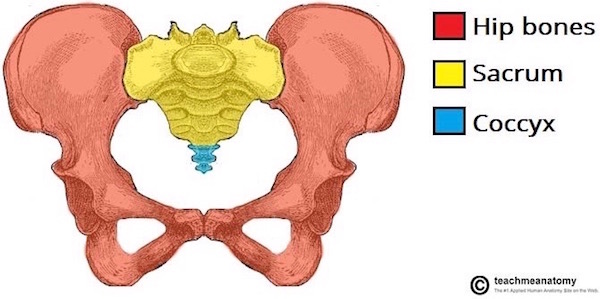
Image K
Another consideration about the bony pelvis: at birth, each hip bone consists of three separate bones, ilium, ischium, and pubis, joined together by cartilage – one reason why there is righteous concern over young children doing rigorous gymnastics. By age 25, the three bones of each side, fuse and ossify into a single hip bone (Image L – right hip bone). From a lateral (side) view, the three bones meet at the acetabulum, the socket for the femoral head.
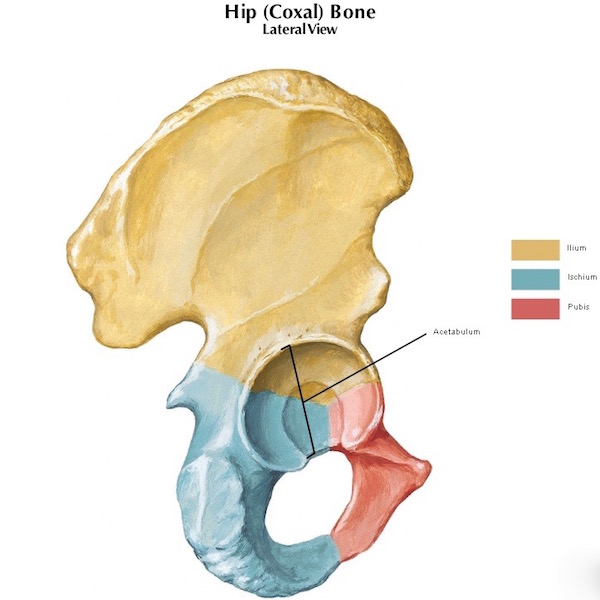
Image L
Pubic bones join in the midline at the pubic symphysis (Image M). The ilia (pl.) form relatively immovable joints with the sacrum at the infamous sacroiliac (SI) joints (Image M – black arrows). The top opening of the bony pelvis is the pelvic inlet (Image M – dashed black oval). Flip the bony ring upside down and the bottom opening is the pelvic outlet (not shown, so use your imagination). The space beneath the pubic symphysis is the sub-pubic angle (Image M – red arrow).
Interestingly, if x-ray reveals a break in the bony pelvis, there will always be at least one or more additional breaks. Try breaking a round pretzel… one cannot break just one side… same with the bony pelvis.
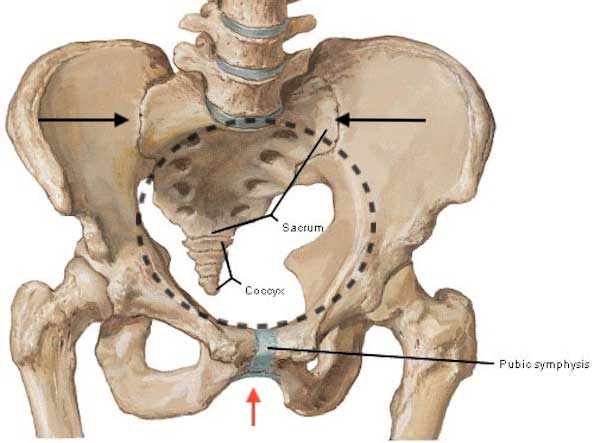
Image M
Now that we understand the bony pelvis, back to sexual dimorphism… Table A summarizes typical differences between adult male and female bony pelves (pl.). Although there are always outliers, female pelves generally express traits that augment pregnancy and childbirth.
TABLE A
| Males | Female |
| Thick and heavy | Thin and light |
| Narrower, taller pelvis | Wider, shallower pelvis |
| Sub-pubic angle < 90° | Sub-pubic angle > 90° |
| Pelvic inlet heart-shaped | Pelvic inlet oval and rounded |
| Sacrum tilted forward | Sacrum tilted backward |
| Small pelvic outlet | Large pelvic outlet |
Following puberty, the female bony pelvis grows becoming wider and shallower than the male pelvis (compare Table A with Image N). Let’s consider these differences.
The female sub-pubic angle is typically 90° or greater (Image N – green inverted V). The male sub-pubic angle is less than 90° (Image N – red inverted V). If one opens the space between thumb and index finger to a right or 90°angle; this is the typical extent of the female sub-pubic angle. If one spreads index and middle fingers as far apart as possible; this angle is less than 90° and is typical of the male sub-pubic angle. This is how anthropologists, forensic experts, and anatomists quickly identify the gender (historically, anatomists use the terms sex and gender interchangeably) of a bony pelvis.
Next, the female pelvic inlet is usually large and oval-shaped (Image N – top, right); the male pelvic inlet is small and heart-shaped (Image N – top, left).
Lastly, the female sacrum typically tilts backward such that the pelvic inlet of a standing woman faces mostly forward. Because the male sacrum tilts forward, the pelvic inlet faces mostly upwards.
Pop quiz! Return to Image F and determine if the yellow and green skeleton belongs to a female or a male. Answer follows Image N.
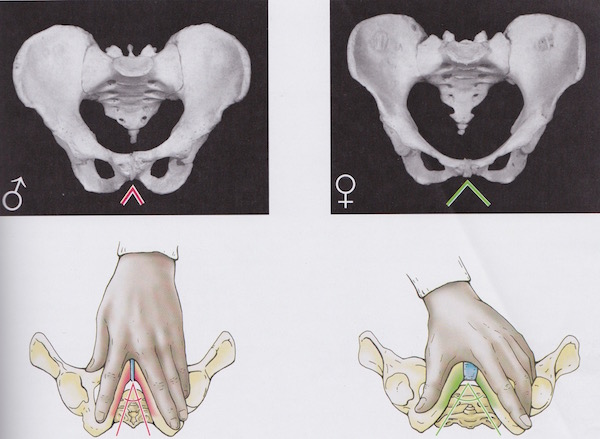
Image N
If you answered female, you are ready for a guest spot on one of those forensic TV shows. Congrats!
We now understand anatomy of the skeleton but what purpose does it serve? Well, it actually serves at whopping six purposes:
Support: Our flesh in the form of muscles, ligaments, tendons, blood and lymphatic vessels, nerves, and so forth, enshrouds the skeleton. If we did not have an endoskeleton for support and movement, we might look something like Mr. Blobfish (Image O), a deep sea fellow living off the coasts of Australia, Tasmania and New Zealand!
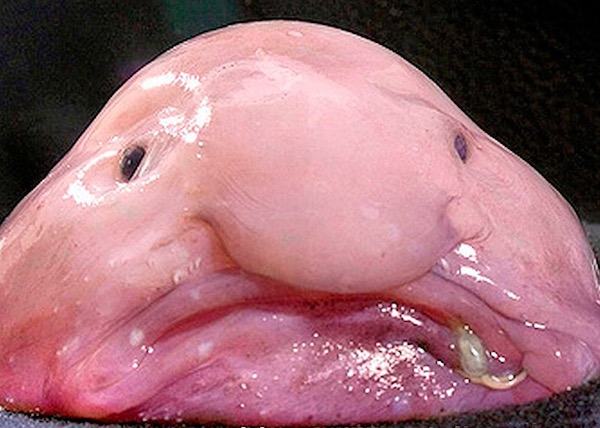
Image O
Movement: The body contains three different types of muscle: smooth, cardiac and skeletal. Skeletal muscles attach to bones via origins and insertions. As a skeletal muscle contracts, it moves the bone(s) to which it attaches. It goes without saying that movement allows us to negotiate our environment for survival.
We have over 700 named skeletal muscles accounting for over half our body weight! The foot of a running man from a 2008 Body World’s exhibit (Image P) shows 12 muscles (there are more that are not shown) of the right foot and leg engaged in lower limb locomotion… add the left leg and foot and the number doubles! Add muscles of thigh and buttocks and, the numbers continue to climb. What a wonder!
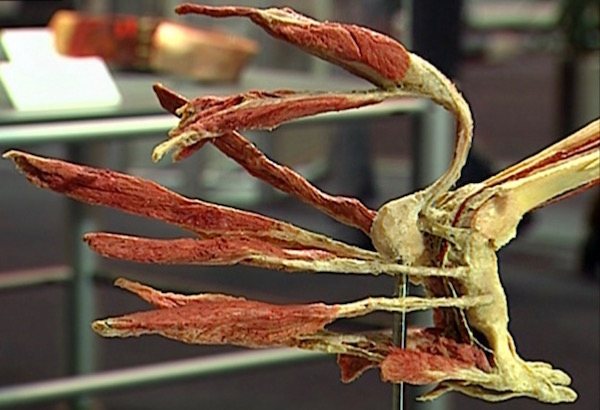
Image P: Running man KLS edited
Protection: The skeleton offers sanctuary for vital organs such as brain and heart (Image Q). Seated in its bony thoracic cage (Anatomy Lesson #15, “Crouching Grants – Hidden Dagger”), all sides of the heart except its diaphragmatic surface are surrounded by bone. Ditto for trachea (most of it), lungs, bronchi, aorta, kidneys, brain, pituitary gland, eyes, tongue, etc., etc., etc. Our well-being has a vested interest in preserving vital organs from injury so surrounding them with bone is an ingenious devise.
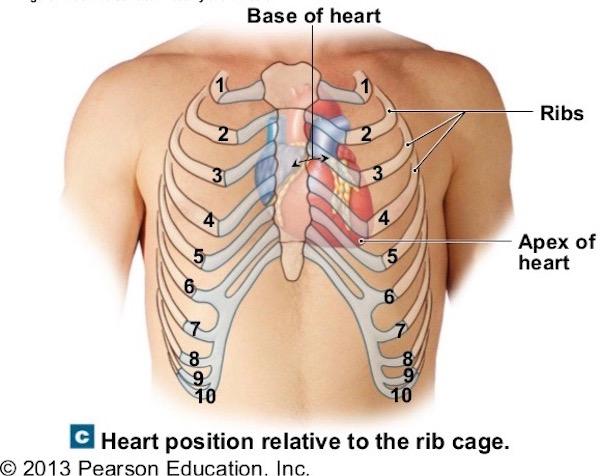
Image Q
Hematopoiesis: Aaaah… What does this term mean? Hematopoiesis means the production of blood cells (Image R). Greatly simplifying a very complex process, circulating blood contains six classes of blood cells plus platelets (Anatomy Lesson #37, “Outlander Owies! – Part 3, Mars and Scars”), all of which arise in bone marrow. Side note: one class of blood cells (lymphocytes) also develop during immune responses in sites outside bone marrow.
Adding another layer of complexity, hematopoiesis is a tortuous process which varies throughout life (Image R). In utero, blood cells arise in the yolk sac (human embryos have one), liver, spleen, lymph nodes, and by the third trimester, in bone marrow. In children, the entire skeleton is engaged in hematopoiesis (it stops in the earlier organs). By adulthood, hematopoiesis confines itself to the ends of long bones and the axial skeleton. Sadly, in the aged, hematopoiesis declines even more, leaving elderly people challenged to produce enough blood cells for good health (exercise helps thwart this decline). Interestingly, blood-forming potential is retained such that under rare conditions, adult liver and spleen can resume hematopoiesis.
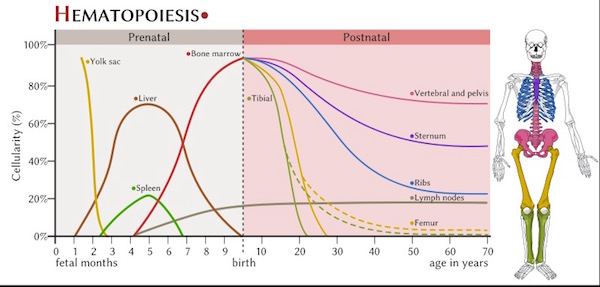
Image R
Storage of Minerals: Remember calcium, phosphate, and magnesium that crystalize into bony hydroxyapatite deposits? As we know, these microscopic crystals form either compact bone or spongy bone (Image S – spongy bone). Either way, given the proper signals, the stored minerals can be mobilized from bone and released into the blood stream for other needs in the body. Thus, bones play an important role as storage depots for minerals.
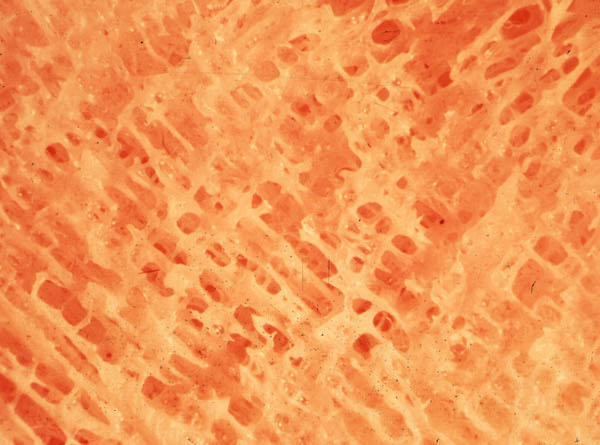
Image S
Hormone Regulation: Last but never least, bone plays a hormonal role. Yes! Bone cells mostly in the medullary (marrow) cavity (Image T) produce two hormones. One, phosphatonin, targets the kidneys causing them to increase phosphate loss in urine thus regulating levels in the blood stream. A second, osteocalcin, stimulates pancreatic cells to release insulin and testicular (Leydig) cells to release testosterone. Ergo, bones are awesome, low-paid multi-taskers!
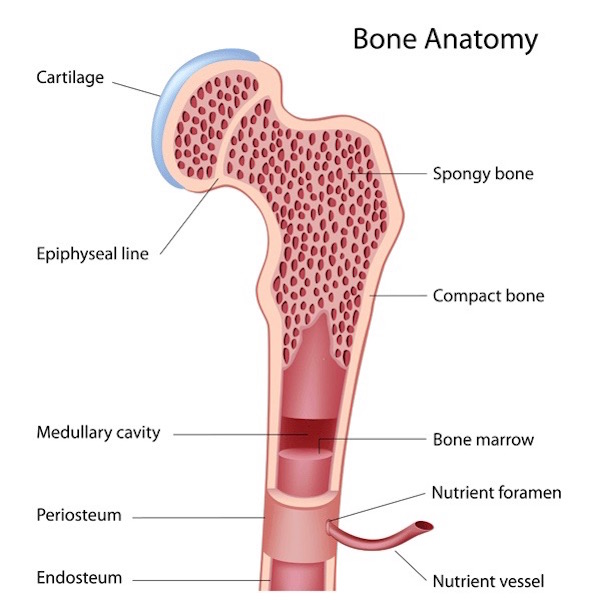
Image T
One last point before this lesson goes bye-bye. What about teeth? Where do they fit into the bony scheme? Most anatomists group teeth with the skeleton, in part because like the skeleton, they remain after all other tissues succumb. And, like bone, tooth enamel is made of specialized hydroxyapatite crystals, although harder, as enamel is the hardest substance in the body.
But, the real reason teeth are saved for the end of this lesson is because the devil made me do it! Yep, BJR is my “go to” guy (Starz episode 206, Best Laid Schemes)!
Moralizing Moment – S.2… Dueling with Jamie, the Snap-Dragon eschews codes duello as he sinks a Munch-Crunch into Jamie’s right arm (puir Jamie, he gets bitten a bunch in S.2)!
A duel bite? Shocking ! What “officer and gentleman” would disarm an opponent’s arm via a carnassal-chomp?
Where’s Murtagh, Jamie’s second, to demand the “field of honour” remains honorable? Sadly, Godfather is long gone – off to Portugal selling hijacked wine.
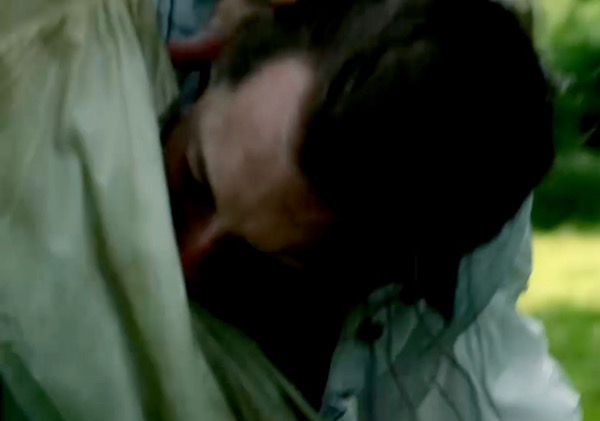
This is a perfect spot for Moralizing Moment – S.1. Something has been bugging me for months!
Some high level Outlander folks once opined that BJ has a “code of honor” because he kept his word, allowing Claire to escape Wentworth in exchange for Jamie’s surrender. Och! I beg to differ. He is as despicable about that “promise” as about Battle-Bites.
I posit that Claire was “dishonorably discharged” from that hell-hole. Does shoving an unsuspecting lass down a 3-4 meter shaft seem honorable to you (Starz episode 115, Wentworth Prison)? Snort!
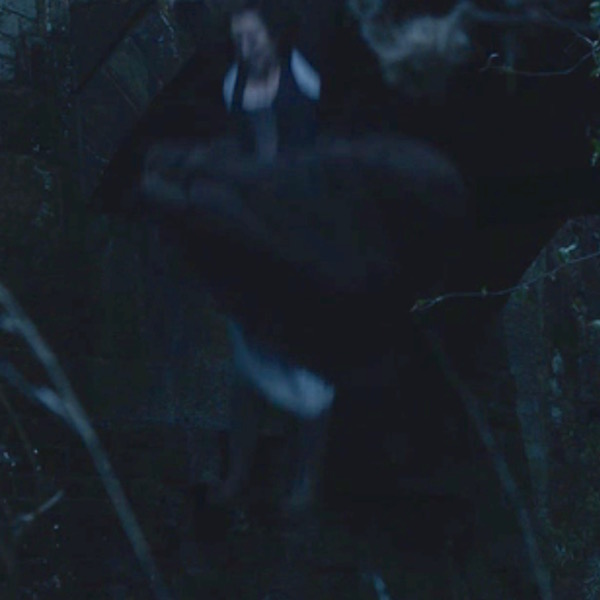
We have come to expect mind-boggling acts from Jack-the-Nipper – that fall could have broken Claire’s back. And, ugh, he pushes her into Wentworth’s garbage/dead body dump, where she finds Taran. We miss you big guy!
Holding a torch aloft, Jack-Jaw surveys his handiwork. Seeing Claire move, he can now “honorably” inform Jamie that his beloved has “left the building” (Starz episode 115, Wentworth Prison)! Ruadh, being a man of honor, honors his “end” of the bargain. Moral to the story: never dance with that dishonorable devil!
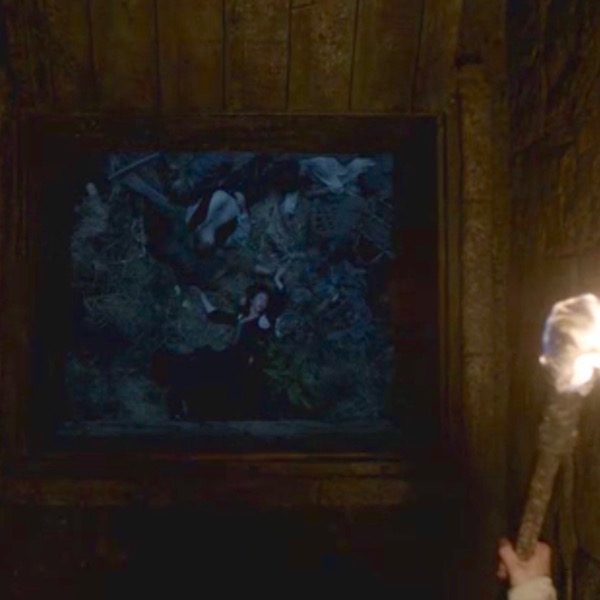
But, take comfort, budding anatomists……. Diana reminds us in a quote from Dragonfly in Amber that love redeems all, even dem bones (and teeth) – ! Yay, the skeleton scores!
” ’Blood of my blood, bone of my bone …’” “I give ye my body, that we may be one,” he finished. “Aye, and I have kept that vow, Sassenach, and so have you.” He turned me slightly, and one hand cupped itself gently over the tiny swell of my stomach.
Whose your daddy (Starz, episode 206, Best Laid Schemes)? Hee hee!
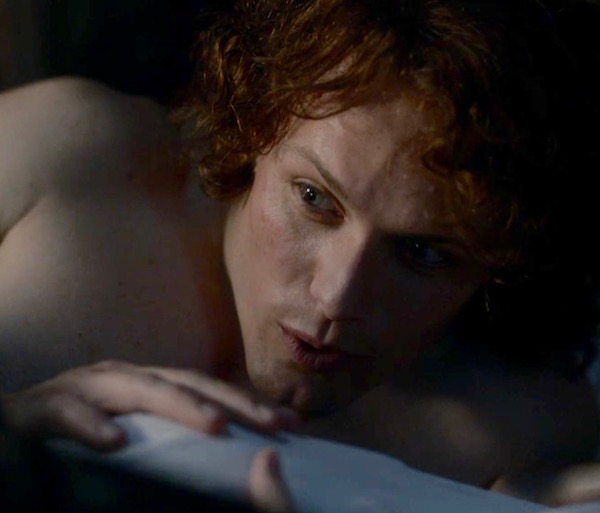
“Let us rise up and be thankful. For if we didn’t learn a lot today, at least we learned a little… ”
-Buddha
Next lesson: how bones heal.
See you later, alligator….. that creature hanging in the apothecary shop. Oops! It’s an “after a while crocodile” dangling from Raymond’s rafters! Ta-ta!
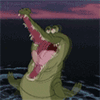
A deeply grateful,
Outlander Anatomist
Photo creds: , Starz, Sony Pictures, Archival image from Outlander Anatomy collection (Image S), National Geographic Magazine, March 2016 (Image A), Body Worlds specimen (Image P), Frank H. Netter, 4th ed., Atlas of Human Anatomy (Image L; Image M), Kieth L. Moore and Arthur F. Dalley, 5th ed.,Clinically Oriented Anatomy (Image N), YouTube (dem bones), www.anthropology.si.edu (Image C), www.arbordoctor.net (Image B), www.archive.museumoflondon.org.uk (Image E), www.bbc.co.uk (Image I), www.en.wikipedia.org (Image H; Image R), www.highlands.edu (Image J), www.nim.nih.gov (Image T), www.skeletalsystemdev.weebly.com (Image F), www.slideshare.net (Image Q), www.teachmescience.info (Image K), www.theinertia.com (Image O), www.theknee.com (Image G), www.wikiradiography.net (Image D), Walt Disney’s Fantasia.
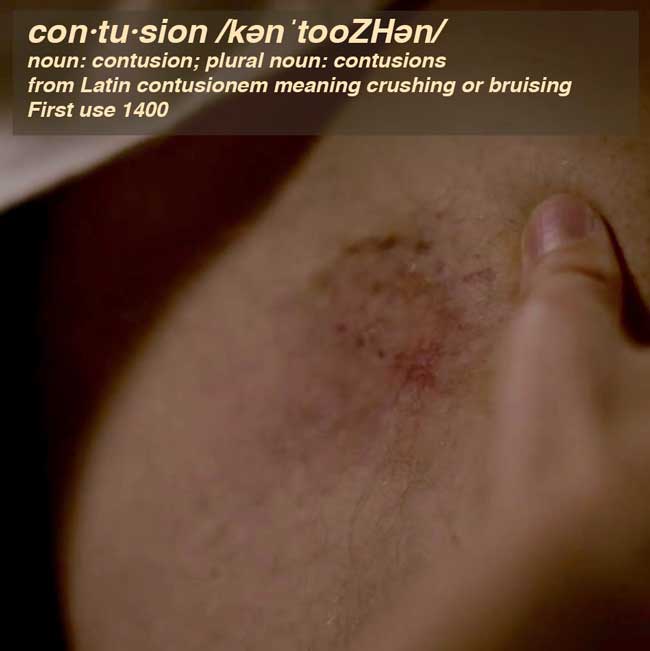
Anatomy def: region of injured tissue or skin in which blood capillaries have been ruptured; a bruise.
Outlander def: “Laddie, you-in-big-trouble-now” patch of flesh, bruised by wickedly sharp teeth!
Learn about contusions in Anatomy Lesson # 35, “Outlander Owies! – Part One” and Anatomy Lesson #37, “Outlander Owies Part 3 – Mars and Scars”
Read about Jamie’s thigh bruises in Diana Gabaldon’s Dragonfly in Amber!
“What,” I said again, “happened to you?” … high on the inside of one leg was what could be nothing other than a bite; the toothmarks were plainly visible.
…“Sassenach,” he said, “what do ye think I’ve been doing?” “Er, well,” I said, trying and failing to keep my eyes away from the marks on his thigh.
…are those the scars of honorable combat, gained in defending your virtue?” … “Yes,”
He said calmly.
See Jamie’s thigh contusions in Starz episode 204, La Dame Blanche!
a deeply grateful,
Outlander Anatomist